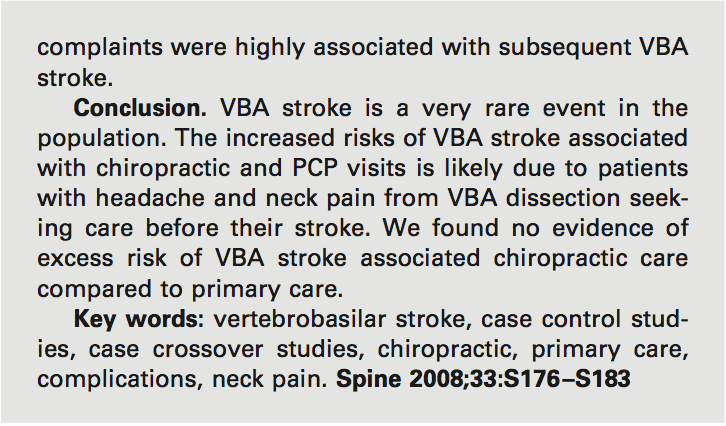Wellness
Clinic Wellness Team. A key factor to spine or back pain conditions is staying healthy. Overall wellness involves a balanced diet, appropriate exercise, physical activity, restful sleep, and a healthy lifestyle. The term has been applied in many ways. But overall, the definition is as follows.
It is a conscious, self-directed, and evolving process of achieving full potential. It is multidimensional, bringing together lifestyles both mental/spiritual and the environment in which one lives. It is positive and affirms that what we do is, in fact, correct.
It is an active process where people become aware and make choices towards a more successful lifestyle. This includes how a person contributes to their environment/community. They aim to build healthier living spaces and social networks. It helps in creating a person’s belief systems, values, and a positive world perspective.
Along with this comes the benefits of regular exercise, a healthy diet, personal self-care, and knowing when to seek medical attention. Dr. Jimenez’s message is to work towards being fit, being healthy, and staying aware of our collection of articles, blogs, and videos.

by Dr Alex Jimenez DC, APRN, FNP-BC, CFMP, IFMCP | Chiropractic, Chiropractic News, Health
�Systematic Review and Meta-analysis of
Chiropractic Care and Cervical Artery
Dissection: No Evidence for Causation
Disclosures can be found in Additional Information at the end of the article
Background
Case reports and case control studies have suggested an association between chiropractic neck manipulation and cervical artery dissection (CAD), but a causal relationship has not been established. We evaluated the evidence related to this topic by performing a systematic review and meta-analysis of published data on chiropractic manipulation and CAD.
Methods
Search terms were entered into standard search engines in a systematic fashion. The articles were reviewed by study authors, graded independently for class of evidence, and combined in a meta-analysis. The total body of evidence was evaluated according to GRADE criteria.
Results
Our search yielded 253 articles. We identified two class II and four class III studies. There were no discrepancies among article ratings (i.e., kappa=1). The meta-analysis revealed a small association between chiropractic care and dissection (OR 1.74, 95% CI 1.26-2.41). The quality of the body of evidence according to GRADE criteria was “very low.”
Conclusions
The quality of the published literature on the relationship between chiropractic manipulation and CAD is very low. Our analysis shows a small association between chiropractic neck manipulation and cervical artery dissection. This relationship may be explained by the high risk of bias and confounding in the available studies, and in particular by the known association of neck pain with CAD and with chiropractic manipulation. There is no convincing evidence to support a causal link between chiropractic manipulation and CAD. Belief in a causal link may have significant negative consequences such as numerous episodes of litigation.
Categories: Neurology, Neurosurgery, Public Health
Keywords: vertebral atery dissection, cervical artery dissection, chiropractic manipulation, cervical manipulation, internal carotid artery dissection, cervical spine manipulative therapy
Introduction
� Copyright 2016
Church et al. This is an open access article distributed under the terms of the Creative Commons Attribution License CC-BY 3.0., which permits unrestricted use, distribution, and reproduction in any medium, provided the original author and source are credited.
|
How to cite this article
Church E W, Sieg E P, Zalatimo O, et al. (February 16, 2016) Systematic Review and Meta-analysis of Chiropractic Care and Cervical Artery Dissection: No Evidence for Causation. Cureus 8(2): e498. DOI 10.7759/cureus.498
|
Neck pain is a common complaint in physicians� and chiropractors� offices. Data from the Centers for Disease Control and from national surveys document 10.2 million ambulatory care visits for a neck problem in 2001 and 2002. By comparison, there were 11 million office-based visits for ischemic heart disease [1]. Many patients with neck pain seek chiropractic care and undergo cervical manipulation. As many as 12% of North Americans receive chiropractic care every year, and a majority of these are treated with spinal manipulation [2].
In contrast to the frequency of neck pain and chiropractic treatments, spontaneous cervical artery dissection (CAD) is rare. The annual incidence of internal carotid artery dissection has been estimated at 2.5�3 per 100,000 patients and that of vertebral artery dissection at 1�1.5 per 100,000 [3]. Stroke occurs in a small proportion of those with CAD, and its true incidence is difficult to estimate. Overall, dissection accounts for two percent of all ischemic strokes [4].
Case reports and case series of cervical dissection following manipulation have been published. Despite their rarity, these cases are frequently publicized for several reasons. Patients are often young and otherwise in good health. Dissection accounts for 10�25% of ischemic strokes in young and middle aged patients [4]. If dissection is caused by cervical manipulation it is potentially a preventable condition. Recent reports, including case control studies, have suggested an association between chiropractic neck manipulation and cervical dissection [5- 10]. Notably, a recent study from the American Heart Association evaluated the available evidence and concluded such an association exists [11]. This report did not include a meta- analysis, nor did it seek to classify studies and grade the body of evidence. We sought to examine the strength of evidence related to this question by performing a systematic review, meta-analysis, and evaluation of the body of evidence as a whole.
Materials & Methods
Search terms �chiropract*,� �spinal manipulation,� �carotid artery dissection,� �vertebral artery dissection,� and �stroke� were included in the search. We used the Medline and Cochrane databases. We additionally reviewed references of key articles for completeness. A librarian with expertise in systematic review was consulted throughout the search process.
Two study authors independently reviewed all articles (EC, ES). They selected any applicable studies for evaluation based on pre-specified inclusion and exclusion criteria. We included only human trials examining patients with carotid or vertebrobasilar artery dissection and recent chiropractic neck manipulation. We excluded non-English language studies. The articles were independently graded using the classification of evidence scheme adopted by the American Academy of Neurology [12-14]. A third author (MG) arbitrated any discrepancies in the class- of-evidence ratings for the included studies.
Data from all class II and III studies were included in a meta-analysis. A second meta-analysis excluding class III studies was also performed. The inverse variance method and a fixed effects model were employed. Additionally, we report results using a variable effects model. The analyses were performed using RevMan 5.3 software from the Cochrane Informatics and Knowledge Management Department. We did not compose a protocol for our review, although PRISMA and MOOSE methodologies were used throughout [15-16].
We evaluated the total body of evidence for quality using the GRADE system [17-20]. A final GRADE designation was achieved by consensus after discussions involving all study authors as recommended by GRADE guidelines. This system is designed to assess the total body of evidence rather than individual studies. The criteria include study design, risk of bias, inconsistency, indirectness, imprecision, publication bias, effect size, dose response, and all plausible residual confounding. Four possible final designations are specified: high, moderate,�low, and very low quality.
Results
Results of the systematic review
Our search strategy yielded 253 articles. Seventy-seven were judged by all reviewers to be non- relevant. Four articles were judged to be class III studies, and two were rated class II. There were no discrepancies between the independent ratings (i.e., kappa=1). Studies rated class III or higher are listed in Table 1. Figure 1 outlines our process of selecting studies for inclusion in the meta-analysis.
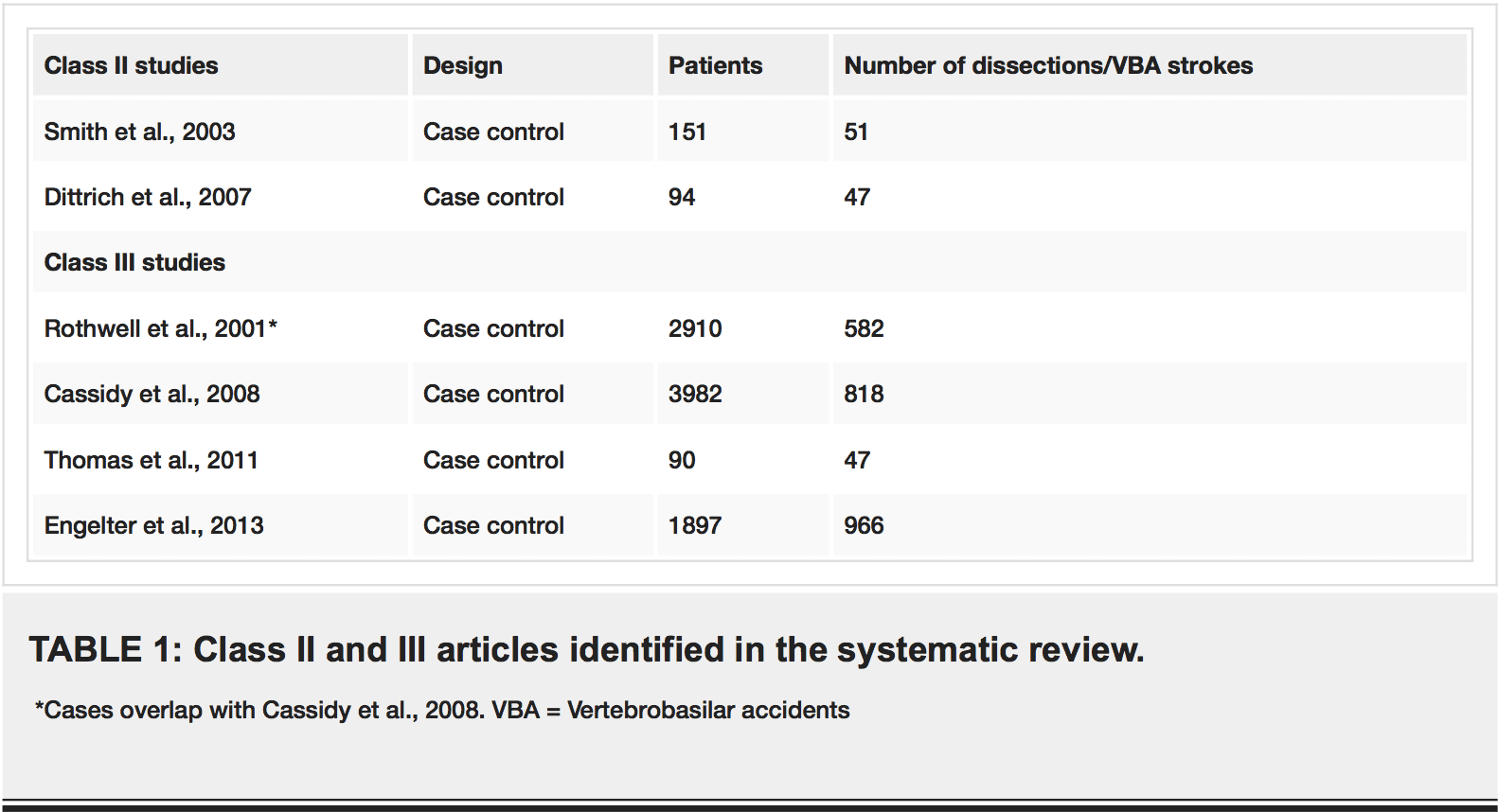
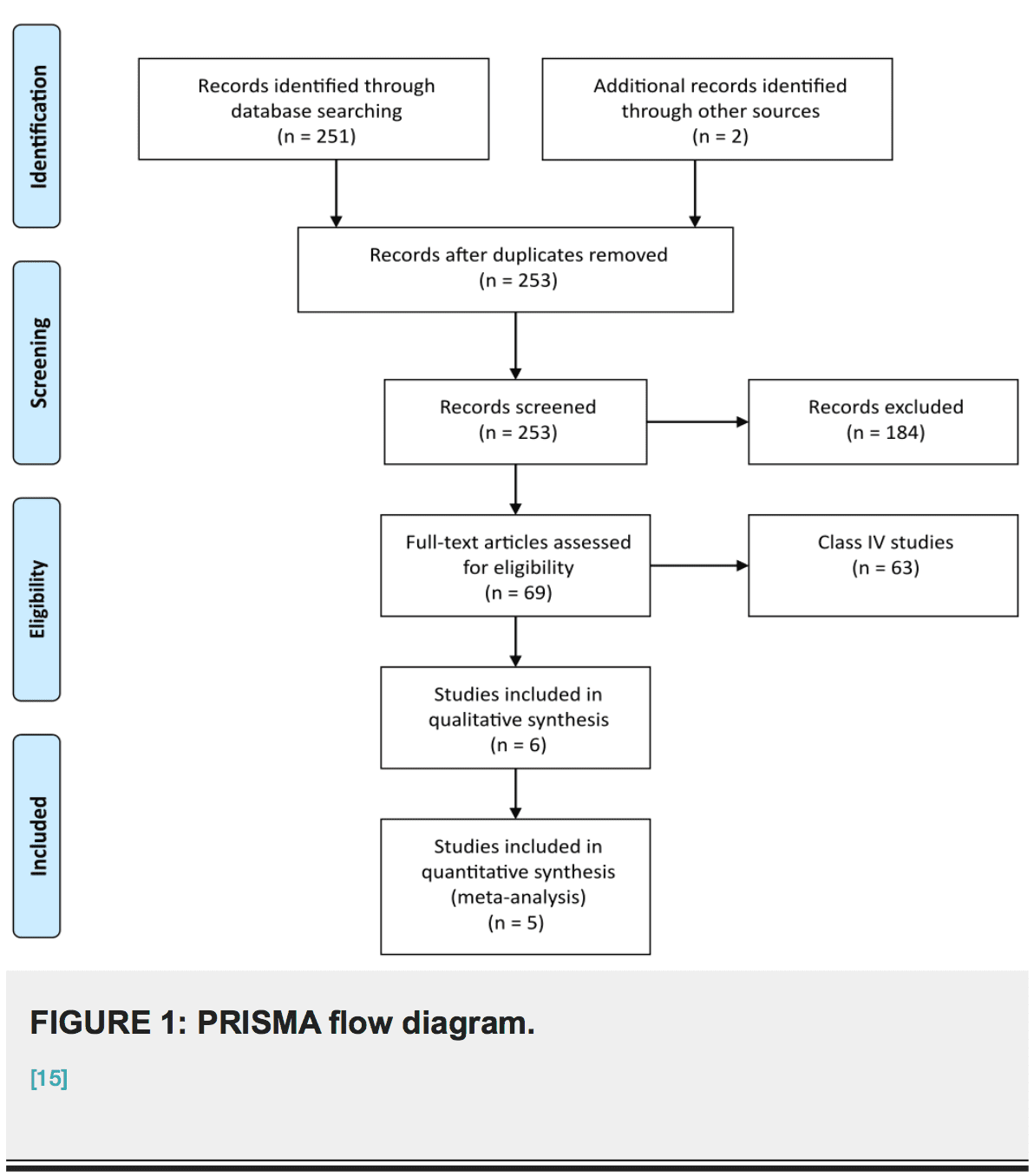
Meta-Analysis
Combined data from class II and III studies suggests an association between dissection and chiropractic care, OR 1.74, 95% CI 1.26-2.41 (Figure 2). The result was similar using a random effects model, OR 4.05, 95% CI 1.27-12.91. We did not include the study by Rothwell et al. because it describes a subset of patients in the study by Cassidy et al. [5,8]. There was considerable heterogeneity among the studies (I2=84%).
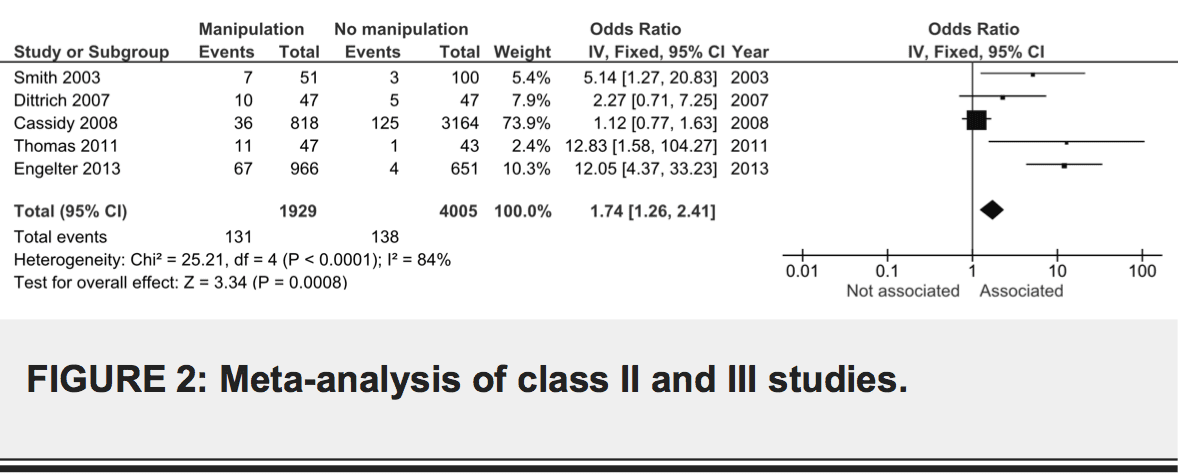
We repeated the meta-analysis excluding class III studies. The combined effect size was again indicative of a small association between dissection and chiropractic care, OR 3.17, 95% CI 1.30-7.74). The result was identical when using a random effects model.
Class II Studies
Smith et al. used a retrospective case control design, combining databases from two academic stroke centers to identify cases of arterial dissection [9]. They found 51 cases and 100 controls. Exposure to spinal manipulative therapy (SMT) was assessed by mail survey. The authors reported an association between SMT and VBA (P = .032). In multivariate analysis, chiropractor care within 30 days was associated with VBA, even when adjusting for neck pain or headache (OR 6.6, 95% CI 1.4-30). While this study controlled for possible confounders such as neck pain, there were several limitations. Head and neck pain as well as chiropractor visit were assessed in a retrospective fashion by mail survey, very possibly introducing both recall and survivor bias. The reason for reporting to the chiropractor (e.g., trauma) was not assessed. Further, there was significant variability among diagnostic procedures, which may reflect increased motivation by physicians to rule out dissection in patients with a history of SMT. Such motivation could result in interviewer bias.
Dittrich et al. compared 47 patients with CAD to a control group with stroke due to etiologies other than dissection [6]. They assessed for risk factors using a face-to-face interview with blinding. These authors found no association between any individual risk factor and CAD, including cervical manipulative therapy. They blame the small sample size for the negative result, and they point out that cumulative analysis of all mechanical risk factors <24 hours prior to symptom onset showed an association (P = .01). This study is subject to recall bias.
Class III Studies
Rothwell et al. used a retrospective case control design to test for an association between chiropractic manipulation and vertebrobasilar accidents (VBA) [8]. They reviewed Ontario hospital records for admissions for VBA from 1993�1998. There were 582 cases and 2328 matching controls. The authors report an association between VBA and visit to a chiropractor within one week (OR 5.03, 95% CI 1.32-43.87), but this was only true for young patients (<45 years). This study represented the first attempt to delineate the association between chiropractic manipulation and extremely rare VBA with controls. Limitations included requisite use of ICD-9 codes to identify cases and associated classification bias, as well as potential unmeasured confounders (e.g., neck pain).
In 2008, Cassidy et al. set out to address the problem of neck pain possibly confounding the association between chiropractic care and VBA [5]. Again using a retrospective case control design, they included all residents of Ontario over a period of 9 years (1993�2002, 109,020,875 person years of observation). They identified 818 VBA strokes resulting in hospitalization and randomly selected age and sex matched controls. Next, they examined ambulatory encounters with chiropractors and primary care physicians (PCPs) in the one year preceding the stroke, limited to cervical manipulation, neck pain, and headache. Associations between chiropractor visit and VBA versus PCP visits and VBA were compared. Indeed, there were associations between both chiropractor visit and VBA (<45yrs OR 1.37, 95% CI 1.04-1.91), and PCP visit and VBA (<45 yrs OR 1.34, 95% CI .94-1.87; >45 yrs and OR 1.53, 95% CI 1.36-1.67). The association for chiropractor visit was not greater than for PCP visit. This data was interpreted as evidence that a confounder such as neck pain may account for the association between chiropractor visit and VBA. This study was subject to many of the same limitations as previous efforts. Canadian health records would not reveal whether a patient with cervical complaints underwent cervical manipulation, and the researchers could not review each chart for imaging confirming dissection. Additionally, the incidence of comorbidities (e.g., hypertension, heart disease,�diabetes) was significantly higher among cases as compared to controls, and we are concerned that these differences were non-random.
In another case control study, Thomas et al. compared the records of 47 patients with confirmed or suspected vertebral or internal carotid artery dissection with 43 controls [10]. They limited their analysis to young patients defined as <55 years. These authors report a significant association between dissection and recent head or neck trauma (OR 23.51, 95% CI 5.71-96.89) as well as neck manual therapy (OR 1.67, 95% CI 1.43-112.0). An inconsistent standard for case ascertainment (a significant number of patients lacked radiographic confirmation of dissection) and lack of blinding weaken this study.
Engelter et al. evaluated data from the Cervical Artery Dissection and Ischemic Stroke Patients (CADISP) consortium, identifying 966 patients with CAD, 651 with stroke attributable to another cause, and 280 healthy controls [7]. The CADISP study involved both prospectively and retrospectively collected data at multiple centers in several countries. They assessed for prior cervical trauma within one month using questionnaires administered during clinic visits. Cervical manipulation therapy was more common for CAD versus stroke from another cause (OR 12.1, CI 4.37-33.2). The report notes that an association between any trauma and CAD was present even when restricting the analysis to prospectively recruited patients. However, in patients to whom the questionnaire was administered after dissection, recall bias may have been at work whether or not the patient was enrolled prospectively. Indeed, the frequency of prior cervical trauma in this study was substantially higher than previous reports (40% versus 12-34%). Additional weaknesses include a highly heterogeneous standard for case definition and no clear masking procedures.
Body Of Evidence Quality (GRADE Rating)
Having performed a systematic review and rated articles according to their individual strengths and weaknesses, we graded the overall body of evidence using the system proposed by Guyatt et al. [17-20]. The GRADE approach to rating quality of evidence proposes four categories that are applied to a body of evidence: high, moderate, low, and very low. In the setting of systematic review, a particular rating reflects the extent of confidence that the estimates of effect are correct. The GRADE approach begins with study design and sequentially examines features with the potential to enhance or diminish confidence in the meta-analytic estimate of effect size.
Our final assessment of the quality of the body of evidence using these criteria was very low. The initial rating based on study design was low (observational studies). Given the controversial nature of this topic and the legal ramifications of results, there is certainly potential for bias (-1 serious). However, blinding in the Class II studies mitigated this risk to some extent. Inconsistency and imprecision did not lower our rating. Because the body of evidence is derived from measures of association, the rating was lowered for indirectness (-1 serious). Publication bias is less likely because of the impact of a negative result in this case. The funnel plot from our meta-analysis was inconclusive with regard to possible publication bias because of the small number of studies included but suggested a deficit in the publication of small negative trials. There was not a large effect size, and currently there is no evidence for a dose response gradient. Moreover, the most worrisome potential confounder (neck pain) would increase rather than reduce the hypothesized effect.
Discussion
The results of our systematic review and meta-analysis suggest a small association between chiropractic care and CAD. There are no class I studies addressing this issue, and this conclusion is based on five class II and III studies. Scrutiny of the quality of the body of data�using the GRADE criteria revealed that it fell within the �very low� category. We found no evidence for a causal link between chiropractic care and CAD. This is a significant finding because belief in a causal link is not uncommon, and such a belief may have significant adverse effects such as numerous episodes of litigation.
The studies included in our meta-analysis share several common weaknesses. Two of the five studies used health administrative databases, and since conclusions depend on accurate ICD coding, this technique for case ascertainment may introduce misclassification bias. It is not possible to account for the type of spinal manipulation that may have been used. Retrospective collection of data is also a potential weakness and may introduce recall bias when a survey or interview was used. Moreover, patients arriving at a hospital complaining of neck pain and describing a recent visit to a chiropractor may be subject to a more rigorous evaluation for CAD (interviewer bias). Another potential source of interviewer bias was lack of blinding in the class III studies. Further, we noted substantial variability among diagnostic procedures performed. All of these weaknesses affect the reliability of the available evidence and are not �corrected� by performing a meta-analysis.
Perhaps the greatest threat to the reliability of any conclusions drawn from these data is that together they describe a correlation but not a causal relationship, and any unmeasured variable is a potential confounder. The most likely potential confounder in this case is neck pain. Patients with neck pain are more likely to have CAD (80% of patients with CAD report neck pain or headache) [21], and they are more likely to visit a chiropractor than patients without neck pain (Figure 3). Several of the studies identified in our systematic review provide suggestive evidence that neck pain is a confounder of the apparent association between chiropractic neck manipulation and CAD. For example, in Engelter et al. patients with CAD and prior cervical trauma (e.g., cervical manipulation therapy) were more likely to present with neck pain but less often with stroke than those with CAD and no prior cervical trauma (58% vs. 43% for trauma and 61% vs. 69% for stroke) [7]. If patients with CAD without neurological symptoms came to medical attention, it was probably because of pain. Patients with neck pain would also be more likely to visit a chiropractor than those without neck pain.
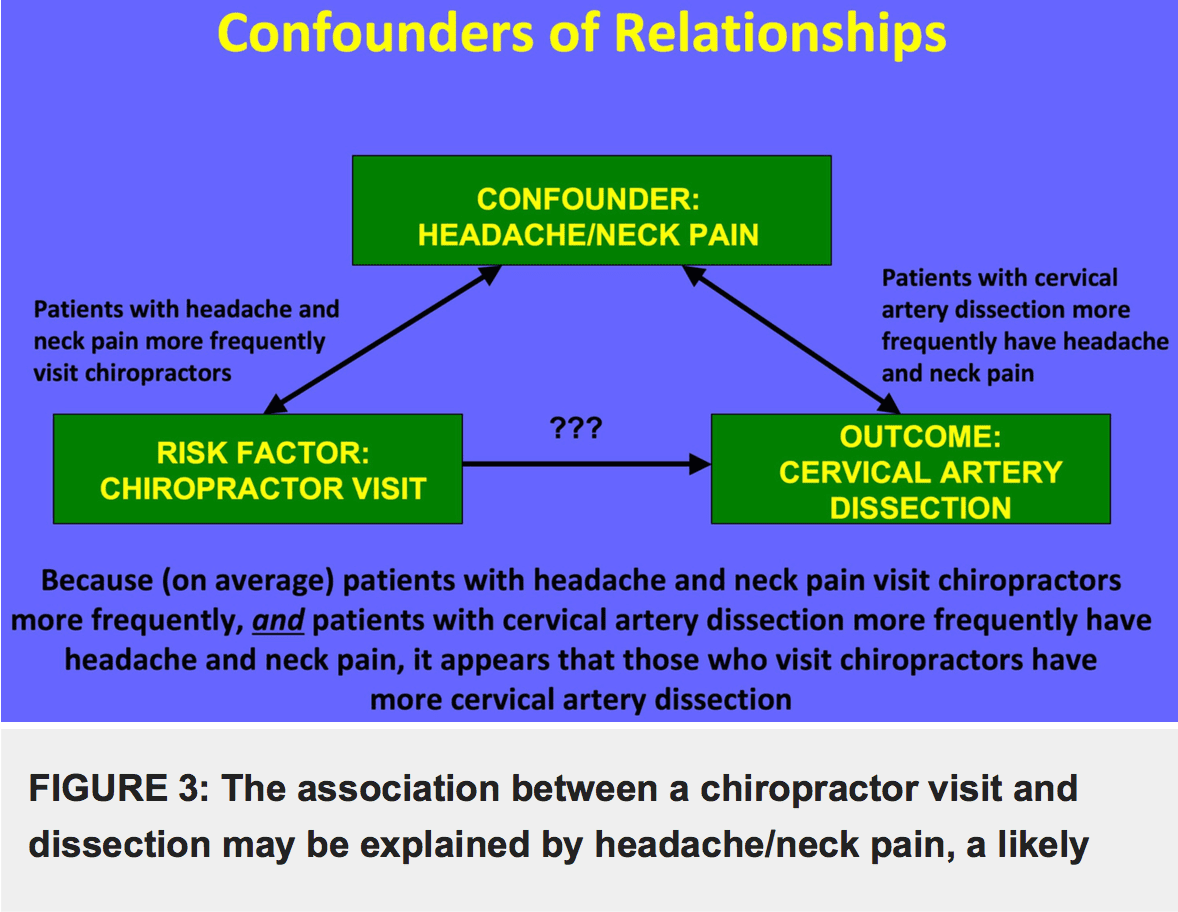

Cassidy et al. hypothesized that, although an association between chiropractor visits and vertebrobasilar artery stroke is present, it may be fully explained by neck pain and headache [5]. These authors reviewed 818 patients with vertebrobasilar artery strokes hospitalized in a population of 100 million person-years. They compared chiropractor and PCP visits in this population and reported no significant difference between these associations. For patients under 45 years of age, each chiropractor visit in the previous month increased the risk of stroke (OR 1.37, 95% CI 1.04-1.91), but each PCP visit in the previous month increased the risk in a nearly identical manner (<45 yrs OR 1.34, 95% CI .94-1.87; >45 yrs and OR 1.53, 95% CI 1.36- 1.67). The authors conclude that, since patients with vertebrobasilar stroke were as likely to visit a PCP as they were to visit a chiropractor, these visits were likely due to pain from an existing dissection.
Cervical artery dissection is a rare event, creating a significant challenge for those who wish to understand it. A prospective, randomized study design is best suited to control for confounders, but given the infrequency of dissection, performing such a study would be logistically and also ethically challenging. Sir Austin Bradford Hill famously addressed the problem of assigning causation to an association with the application of nine tests [22]. These criteria include strength, consistency, specificity, temporality, biological gradient, plausibility, coherence, experimental evidence, and analogy. The specific tests and our assessment for the association between cervical manipulation and CAD are summarized in Table 2. In our appraisal, this association clearly passes only one test, it fails four, and the remaining four are equivocal due to absence of relevant data [23]. Further, a 2013 assessment of the quality of reports of cervical arterial dissection following cervical spinal manipulation similarly found lacking data to support a causal relationship [24].
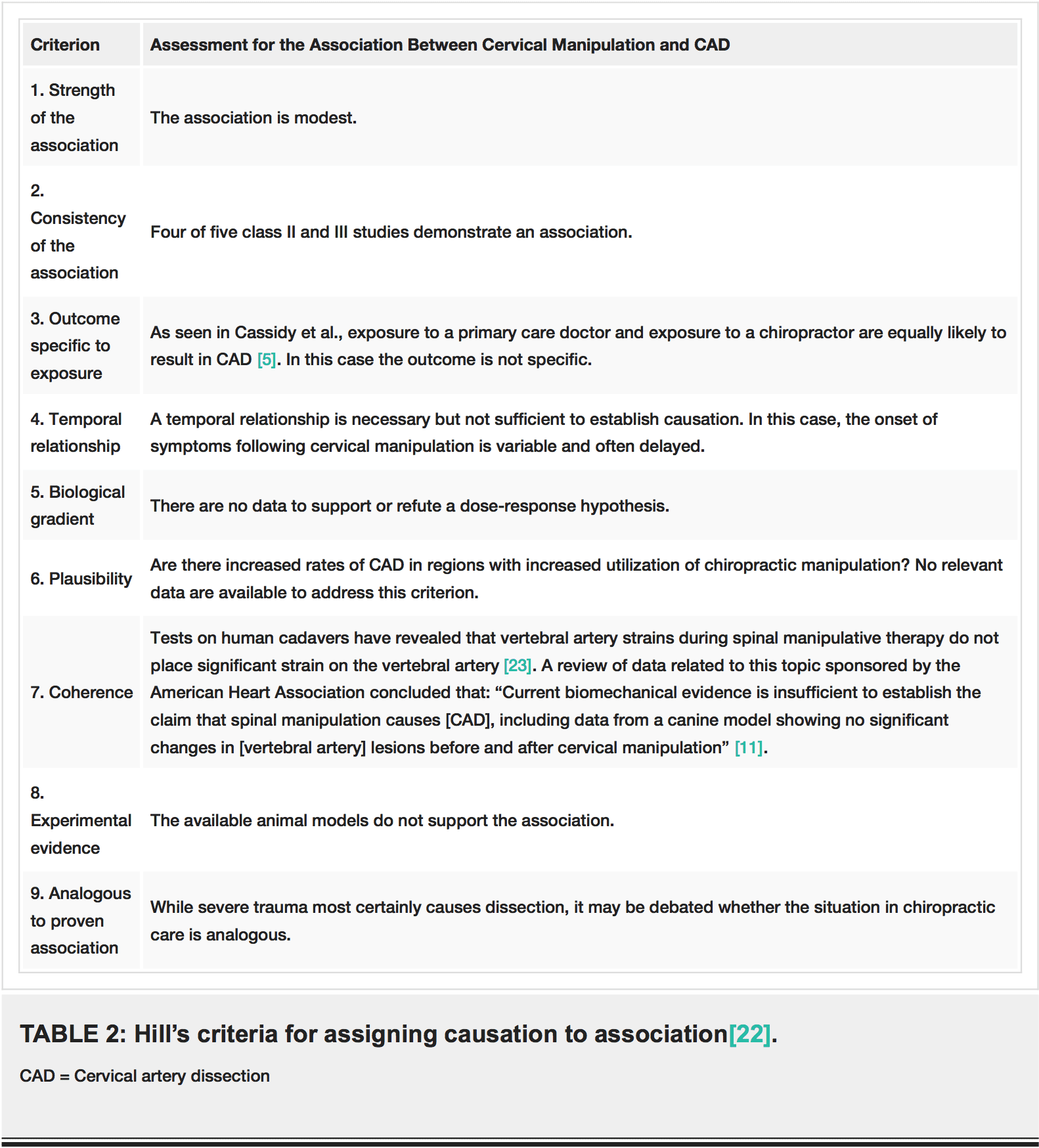
In spite of the very weak data supporting an association between chiropractic neck manipulation and CAD, and even more modest data supporting a causal association, such a relationship is assumed by many clinicians. In fact, this idea seems to enjoy the status of medical dogma. Excellent peer reviewed publications frequently contain statements asserting a causal relationship between cervical manipulation and CAD [4,25,26]. We suggest that physicians should exercise caution in ascribing causation to associations in the absence of adequate and reliable data. Medical history offers many examples of relationships that were initially falsely assumed to be causal [27], and the relationship between CAD and chiropractic neck manipulation may need to be added to this list.
Conclusions
Our systematic review revealed that the quality of the published literature on the relationship between chiropractic manipulation and CAD is very low. A meta-analysis of available data shows a small association between chiropractic neck manipulation and CAD. We uncovered evidence for considerable risk of bias and confounding in the available studies. In particular, the known association of neck pain both with cervical artery dissection and with chiropractic manipulation may explain the relationship between manipulation and CAD. There is no convincing evidence to support a causal link, and unfounded belief in causation may have dire consequences.
Additional Information
Disclosures
Conflicts of interest: The authors have declared that no conflicts of interest exist.
Acknowledgements
The authors wish to thank Elaine Dean, MLS, of the Penn State Hershey Medical Center George T. Harrell Health Sciences Library, for her assistance with the systematic review.
1. Riddle DL, Schappert SM: Volume and characteristics of inpatient and ambulatory medical care for neck pain in the United States: data from three national surveys. Spine. 2007, 32:132�140.
2. Hurwitz EL, Chiang LM: A comparative analysis of chiropractic and general practitioner patients in North America: findings from the joint Canada/United States survey of health, 2002-03. BMC Health Serv Res. 2006, 6:49. 10.1186/1472-6963-6-49
3. Micheli S, Paciaroni M, Corea F, et al.: Cervical artery dissection: emerging risk factors . Open Neurol J. 2010, 4:50�55. 10.2174/1874205X01004010050
4. Schievink WI: Spontaneous dissection of the carotid and vertebral arteries . N Engl J Med. 2001, 344:898�906. 10.1056/NEJM200103223441206
5. Cassidy JD, Boyle E, C�t� PDC, et al.: Risk of vertebrobasilar stroke and chiropractic care: results of a population-based case-control and case-crossover study. Spine. 2008, 33:176�183.10.1097/BRS.0b013e3181644600
6. Dittrich R, Rohsbach D, Heidbreder A, et al.: Mild mechanical traumas are possible risk factors for cervical artery dissection. Cerebrovasc Dis. 2007, 23:275�281. 10.1159/000098327
7. Engelter ST, Grond-Ginsbach C, Metso TM, et al.: Cervical artery dissection: trauma and other potential mechanical trigger events. Neurology. 2013, 80:1950�1957.10.1212/WNL.0b013e318293e2eb
8. Rothwell DM, Bondy SJ, Williams JI: Chiropractic manipulation and stroke: a population based case-control study. Stroke. 2001, 32:1054-1060.
9. Smith WS, Johnston SC, Skalabrin EJ, et al.: Spinal manipulative therapy is an independent risk factor for vertebral artery dissection. Neurology. 2003, 60:1424-1428.10. Thomas LC, Rivett DA, Attia JR, et al.: Risk factors and clinical features of craniocervical arterial dissection. Man Ther. 2011, 16:351�356. 10.1016/j.math.2010.12.008
11. Biller J, Sacco RL, Albuquerque FC, et al.: Cervical arterial dissections and association with cervical manipulative therapy: a statement for healthcare professionals from the American Heart Association/American Stroke Association. Stroke. 2014, 45:3155�3174.10.1161/STR.0000000000000016
12. AAN (American Academy of Neurology): Clinical Practice Guideline Process Manual. Gronseth GS, Woodroffe LM, Getchius TSD (ed): AAN (American Academy of Neurology), St Paul, MN; 2011.
13. French J, Gronseth G: Lost in a jungle of evidence: we need a compass . Neurology. 2008, 71:1634�1638. 10.1212/01.wnl.0000336533.19610.1b 2016 Church et al. Cureus 8(2): e498. DOI 10.7759/cureus.498 10 of 11
14. Gross RA, Johnston KC: Levels of evidence: taking Neurology� to the next level . Neurology. 2009, 72:8�10. 10.1212/01.wnl.0000342200.58823.6a
15. Moher D, Liberati A, Tetzlaff J, et al.: Preferred reporting items for systematic reviews and meta-analyses: the PRISMA statement. PLoS Med. 2009, 6:e1000097. Accessed: January 23, 2016: http://journals.plos.org/plosmedicine/article?id=10.1371/journal.pmed.1000097. 10.1371/journal.pmed.1000097
16. Stroup DF, Berlin JA, Morton SC, et al.: Meta-analysis of observational studies inepidemiology: a proposal for reporting. Meta-analysis of observational studies in epidemiology (MOOSE) group. JAMA. 2000, 283:2008-2012.
17. Guyatt G, Oxman AD, Akl EA, et al.: GRADE guidelines: 1. Introduction-GRADE evidence profiles and summary of findings tables. J Clin Epidemiol. 2011, 64:383�394. 10.1016/j.jclinepi.2010.04.026
18. Guyatt GH, Oxman AD, Kunz R, et al.: GRADE guidelines: 2. Framing the question and deciding on important outcomes. J Clin Epidemiol. 2011, 64:395�400. 10.1016/j.jclinepi.2010.09.012
19. Balshem H, Helfand M, Sch�nemann HJ, et al.: GRADE guidelines: 3. Rating the quality of evidence. J Clin Epidemiol. 2011, 64:401�406. 10.1016/j.jclinepi.2010.07.015
20. The Cochrane Collaboration: Cochrane Handbook for Systematic Reviews of Interventions (Version 5.1.0). Higgins JPT, Green S (ed): The Cochrane Collaboration, 2011.
21. Lee VH, Brown RD Jr, Mandrekar JN, et al.: Incidence and outcome of cervical artery dissection: a population-based study. Neurology. 2006, 67:1809-1812.
22. Hill AB: The environment and disease: association or causation?. Proc R Soc Med. 1965, 58:295�300.
23. Herzog W, Leonard TR, Symons B, et al.: Vertebral artery strains during high-speed, low amplitude cervical spinal manipulation. J Electromyogr Kinesiol. 2012, 22:740�746. 10.1016/j.jelekin.2012.03.005
24. Wynd S, Estaway M, Vohra S, Kawchuk G: The quality of reports on cervical arterial dissection following cervical spinal manipulation. PLOS ONE. 2013, 8:e59170. Accessed: February 8, 2016: http://journals.plos.org/plosone/article?id=10.1371/journal.pone.0059170. 10.1371/journal.pone.0059170
25. Albuquerque FC, Hu YC, Dashti SR, et al.: Craniocervical arterial dissections as sequelae of chiropractic manipulation: patterns of injury and management. J Neurosurg. 2011, 115:1197�1205. 10.3171/2011.8.JNS111212
26. Debette S, Leys D: Cervical-artery dissections: predisposing factors, diagnosis, and outcome . Lancet Neurol. 2009, 8:668�678. 10.1016/S1474-4422(09)70084-5
27. Artenstein AW: The discovery of viruses: advancing science and medicine by challenging dogma. Int J Infect Dis. 2012, 16:e470�e473. 10.1016/j.ijid.2012.03.005
Ephraim W. Church 1 , Emily P. Sieg 1 , Omar Zalatimo 1 , Namath S. Hussain 1 , Michael Glantz 1 , Robert E. Harbaugh 1
1. Department of Neurosurgery, Penn State Hershey Medical Center
Corresponding author: Ephraim W. Church, echurch@hmc.psu.edu

by Dr Alex Jimenez DC, APRN, FNP-BC, CFMP, IFMCP | Chiropractic, Chiropractic News, Health, Physical Rehabilitation
Results Of A Population-Based Case-Control & Case-Crossover Study
J. David Cassidy, DC, PhD, DrMedSc,*�� Eleanor Boyle, PhD,* Pierre Co�te ?, DC, PhD,*��� Yaohua He, MD, PhD,* Sheilah Hogg-Johnson, PhD,�� Frank L. Silver, MD, FRCPC, and Susan J. Bondy, PhD�
SPINE Volume 33, Number 4S, pp S176 �S183 �2008, Lippincott Williams & Wilkins
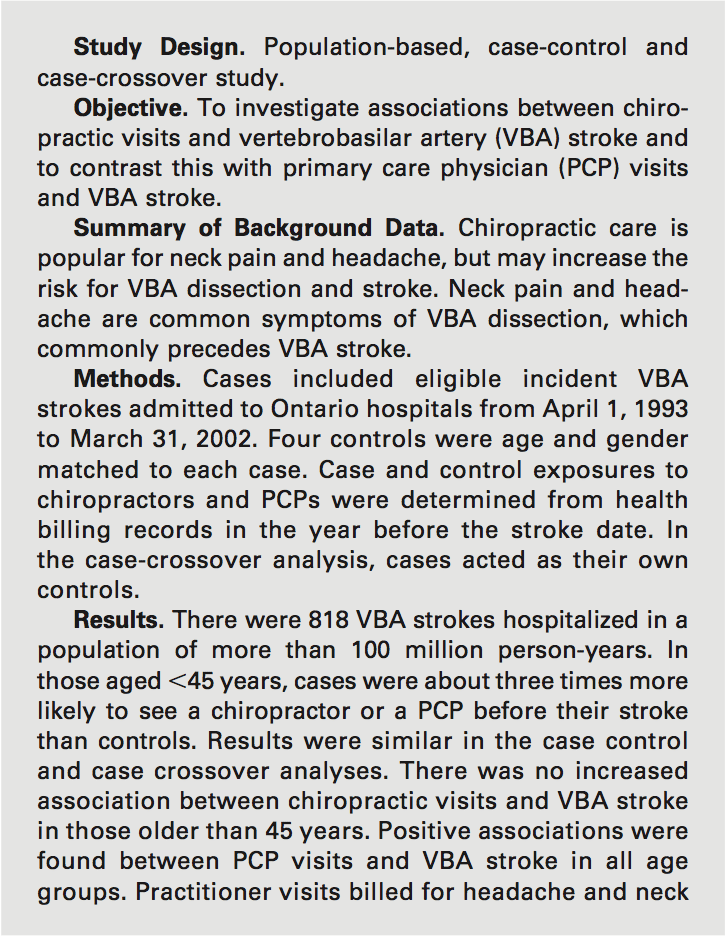
Neck pain is a common problem associated with consid- erable comorbidity, disability, and cost to society.1�5 In North America, the clinical management of back pain is provided mainly by medical physicians, physi- cal therapists and chiropractors.6 Approximately 12% of American and Canadian adults seek chiropractic care annually and 80% of these visits result in spinal manipulation.7,8 When compared to those seeking medical care for back pain, Canadian chiropractic pa- tients tend to be younger and have higher socioeco- nomic status and fewer health problems.6,8 In On- tario, the average number of chiropractic visits per episode of care was 10 (median 6) in 1985 through 1991.7 Several systematic reviews and our best- evidence synthesis suggest that manual therapy can benefit neck pain, but the trials are too small to eval- uate the risk of rare complications.9 �13
Two deaths in Canada from vertebral artery dissection and stroke following chiropractic care in the 1990s attracted much media attention and a call by some neurologists to avoid neck manipulation for acute neck pain.14 There have been many published case reports linking neck manipulation to vertebral artery dissection15�and stroke.�The prevailing theory is that extension�and/or rotation of the neck can damage the vertebral artery, particularly within the foramen transversarium at the C1�C2 level. Activities leading to sudden or sustained rotation and extension of the neck have been implicated, included motor vehicle collision, shoulder checking while driving, sports, lifting, working over- head, falls, sneezing, and coughing.16 However, most cases of extracranial vertebral arterial dissection are thought to occur spontaneously, and other factors such as connective tissue disorders, migraine, hyper- tension, infection, levels of plasma homocysteine, vessel abnormalities, atherosclerosis, central venous�catherization, cervical spine surgery, cervical percutaneous nerve blocks, radiation therapy and diagnostic cerebral angiography have been identified as possible risk factors.17�21
The true incidence of vertebrobasilar dissection is un- known, since many cases are probably asymptomatic, or the dissection produces mild symptoms.22 Confirming the diagnosis requires a high index of suspicion and good vascular imaging. The cases that are most likely to be diagnosed are those that result in stroke.19,22 Ischemic stroke occurs when a thrombus develops intraluminally and embolizes to more distal arteries, or less commonly, when the dissection extends distally into the intracranial vertebral artery, obliterating branching vessels.22 The best incidence estimate comes from Olmstead county, where vertebral artery dissection causing stroke affected 0.97 residents per 100,000 population between 1987 and 2003.23
To date there have been two case-control studies of stroke following neck manipulation. Rothwell et al used Ontario health data to compare 582 cases of VBA stroke to 2328 age and sex-matched controls.24 For those aged 45 years, cases were five times more likely than con- trols to have visited a chiropractor within 1 week of VBA stroke. Smith et al studied 51 patients with cervical ar- tery dissection and ischemic stroke or transient ischemic attack (TIA) and compared them to 100 control patients suffering from other strokes not caused by dissections.25 Cases and controls came from two academic stroke cen- ters in the United States and were matched on age and sex. They found no significant association between neck manipulation and ischemic stroke or TIA. However, a subgroup analysis showed that the 25 cases with verte- bral artery dissection were six times more likely to have consulted a chiropractor within 30 days before their stroke than the controls.
Finally, because patients with vertebrobasilar artery dissection commonly present with headache and neck pain,23 it is possible that patients seek chiropractic care for these symptoms and that the subsequent VBA stroke occurs spontaneously, implying that the associ- ation between chiropractic care and VBA stroke is not causal.23,26 Since patients also seek medical care for headache and neck pain, any association between pri- mary care physician (PCP) visits and VBA stroke could be attributed to seeking care for the symptoms of verte- bral artery dissection.
The purpose of this study is to investigate the association between chiropractic care and VBA stroke and compare it to the association between recent PCP care and VBA stroke using two epidemiological designs. Evidence that chiropractic care increases the risk of VBA stroke would be present if the measured association between chiropractic visits and VBA stroke exceeds the association between PCP visits and VBA strokes.
Study Design
We undertook population-based case-control and case- crossover studies. Both designs use the same cases. In the case- control design, we sampled independent control subjects from the same source population as the cases. In the case-crossover design, cases served as their own controls, by sampling control periods before the study exposures.27 This design is most appropriate when a brief exposure (e.g., chiropractic care) causes a transient change in risk (i.e., hazard period) of a rare-onset disease (e.g., VBA stroke). It is well suited to our research questions, since within person comparisons control for unmeasured risk factors by design, rather than by statistical modeling.28 �30 Thus the advantage over the case control design is better control of confounding.
Source Population
The source population included all residents of Ontario (109,020,875 person-years of observation over 9 years) covered by the publicly funded Ontario Health Insurance Plan (OHIP). Available utilization data included hospitalizations with diagnostic coding, and practitioner (physician and chiropractic) utilization as documented by fee-for-service billings accompanied by diagnostic coding. We used two data sources: (1) the Discharge Abstract Database (DAD) from the Canadian Institute for Health Information, which captures hospital separations and ICD codes, and (2) the OHIP Databases for services provided by physicians and chiropractors. These data- bases can be linked from April 1992 onward.
Cases
We included all incident vertebrobasilar occlusion and stenosis strokes (ICD-9433.0 and 433.2) resulting in an acute care hospital admission from April 1, 1993 to March 31, 2002. Codes were chosen in consultation with stroke experts and an epidemiologist who participated in a similar past study (SB).24 Cases that had an acute care hospital admission for any type of stroke (ICD-9433.0, 433.2, 434, 436, 433.1, 433.3, 433.8, 433.9, 430, 431, 432, and 437.1), transient cerebral ischemia (ICD- 9435) or late effects of cerebrovascular diseases (ICD-9438) before their VBA stroke admission or since April 1, 1991 were excluded. Cases residing in long-term care facilities were also excluded. The index date was defined as the hospital admission date for the VBA stroke.
Controls
For the case-control study, four age and sex-matched controls were randomly selected from the Registered Persons Database, which contains a listing of all health card numbers for Ontario. Controls were excluded if they previously had a stroke or were residing in a long-term care facility.
For the case crossover study, four control periods were randomly chosen from the year before the VBA stroke date, using a time-stratified approach.31 The year was divided into disjoint strata with 2 week periods between the strata. For the 1 month hazard period, the disjoint strata were separated by 1 month periods and the five remaining control periods were used in the analyses. We randomly sampled disjoint strata because chiropractic care is often delivered in episodes, and this strategy eliminates overlap bias and bias associated with time trends in the exposure.32
Exposures
All reimbursed ambulatory encounters with chiropractors and PCPs were extracted for the one-year period before the index date from the OHIP database. Neck-related chiropractic visits were identified using diagnostic codes: C01�C06, cervical and cervicothoracic subluxation; C13�C15, multiple site subluxation; C30, cervical sprain/strain; C40, cervical neuritis/ neuralgia; C44, arm neuritis/neuralgia; C50, brachial radiculitis; C51, cervical radiculitis; and C60, headache. For PCP visits, we included community medicine physicians if they submitted ambulatory fee codes to OHIP. Fee codes for group therapy and signing forms were excluded. Headache or neck pain- related PCP visits were identified using the diagnostic codes: ICD-9307, tension headaches; 346, migraine headaches; 722, intervertebral disc disorders; 780, headache, except tension headache and migraine; 729, fibrositis, myositis and muscular rheumatism; and 847, whiplash, sprain/strain and other traumas associated with neck (These codes include other diagnoses, and we list only those relevant to neck pain or headache). There is no limit on the number of reimbursed PCP visits per year. However, there are limits chiropractors, but less than 15% of patients surpass them.24
Statistical Analysis
Conditional logistic regression was used to estimate the asso- ciation between VBA stroke after chiropractor and PCP visits. Separate models were built using different a priori specified hazard periods, stratified by age ( 45 years and 45 years) and by visits with or without head and neck pain related diag- nostic codes. For the chiropractic analysis, the index date was included in the hazard period, since chiropractic treatment might cause immediate stroke and patients would not normally consult a chiropractor after having a stroke. However, the in- dex day was excluded from the PCP analysis, since patients might consult these physicians after experiencing a stroke. We tested different hazard periods, including 1 day, 3 days, 1 week, 2 weeks, and 1 month before the index date. Exposure occurred if any chiropractic or PCP visits were recorded during the des- ignated hazard periods.
We also measured the effect of cumulative numbers of chiropractic and PCP visits in the month before the index date by computing the odds ratio for each incremental visit. These estimates were similarly stratified by age and by diagnostic codes related to headache and/or neck pain. Finally, we conducted analyses to determine if our results were sensitive to chiropractic and PCP visits related to neck complaints and headaches. We report our results as odds ratios (OR) and 95% confidence intervals. Confidence intervals were estimated by accelerated bias corrected bootstraps with 2000 replications using the variance co-variance method.33 All statistical analyses were per- formed using STATA/SE version 9.2.34
Results
A total of 818 VBA strokes met our inclusion/exclusion criteria over the 9 year inception period. Of the 3272 matched control subjects, 31 were excluded because of prior stroke, one had died before the index date and 76 were receiving long-term care. Thus, 3164 control subjects were matched to the cases. The mean age of cases and controls was 63 years at the index date and 63% were male. Cases had a higher proportion of comorbid conditions (Table 1). Of the 818 stroke cases, 337�(41.2%) were coded as basilar occlusion and stenosis, 443 (54.2%) as vertebral occlusion and stenosis and 38 (4.7%) had both codes.

Overall, 4% of cases and controls had visited a chiropractor within 30 days of the index date, while 53% of cases and 30% of controls had visited a PCP within that time (Table 2). For those under 45 years of age, 8 cases (7.8%) had consulted a chiropractor within 7 days of the index date, compared to 14 (3.4%) of controls. For PCPs, 25 cases (24.5%) under 45 years of age had a consultation within 7 days of the index date, com- pared to 27 (6.6%) of controls. With respect to the number of visits within 1 month of the index date, 7.8% of cases under the age of 45 years had three or more chiropractic visits, whereas 5.9% had three or more PCP visits (Table 2).
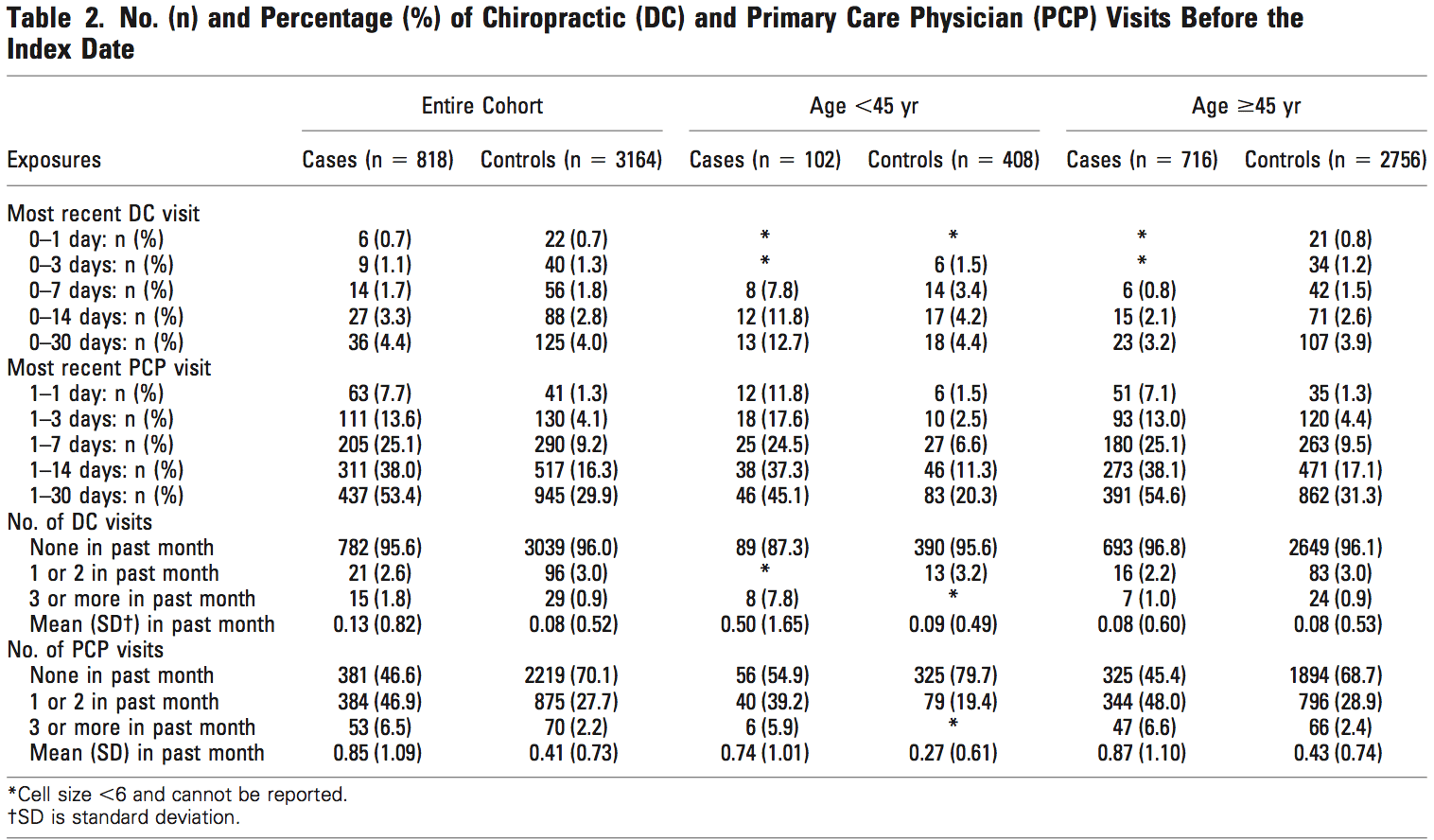
The case control and case crossover analyses gave similar results. (Tables 3�7) Age modified the effect of chiropractic visits on the risk of VBA stroke. For those under 45 years of age, there was an increased association between chiropractic visits and VBA stroke regardless of the hazard period. For those 45 years of age and older, there was no association. Each chiropractic visit in the month before the index date was associated with an in- creased risk of VBA stroke in those under 45 years of age (OR 1.37; 95% CI 1.04�1.91 from the case crossover analysis) (Table 7). We were not able to estimate boot- strap confidence intervals in some cases because of sparse data.

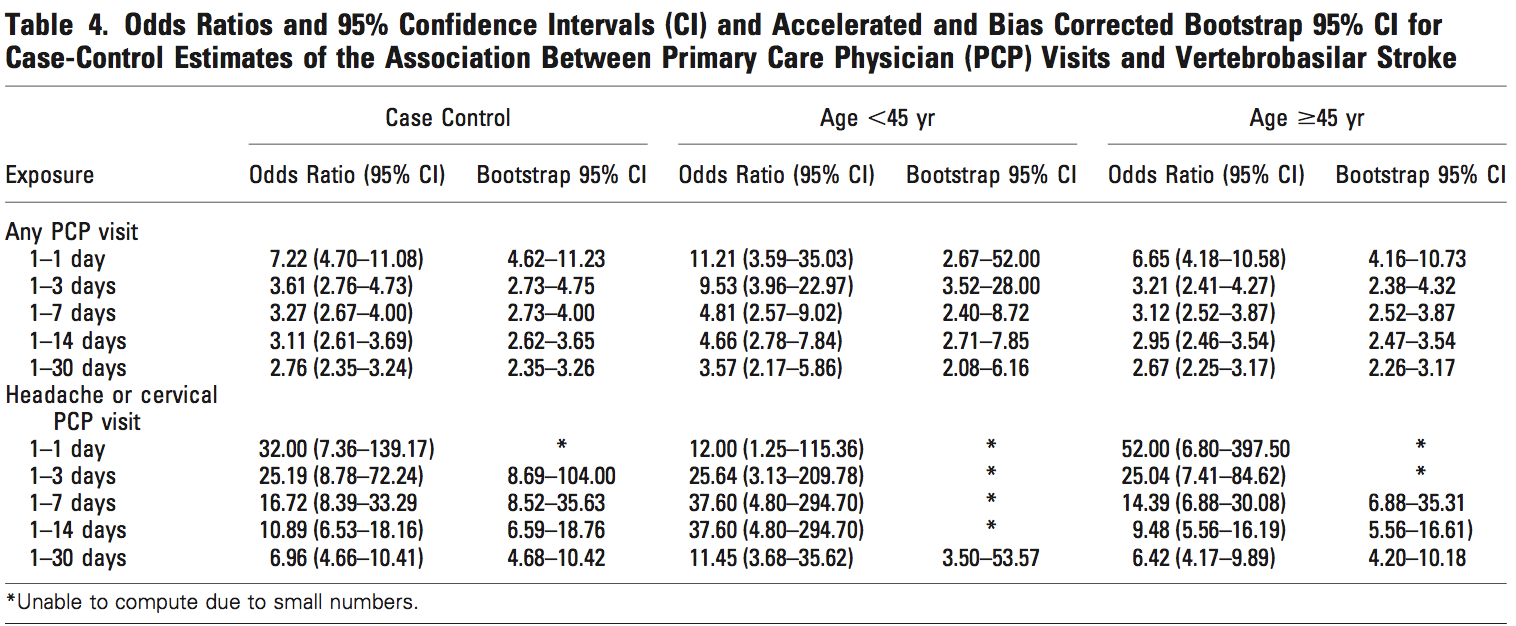
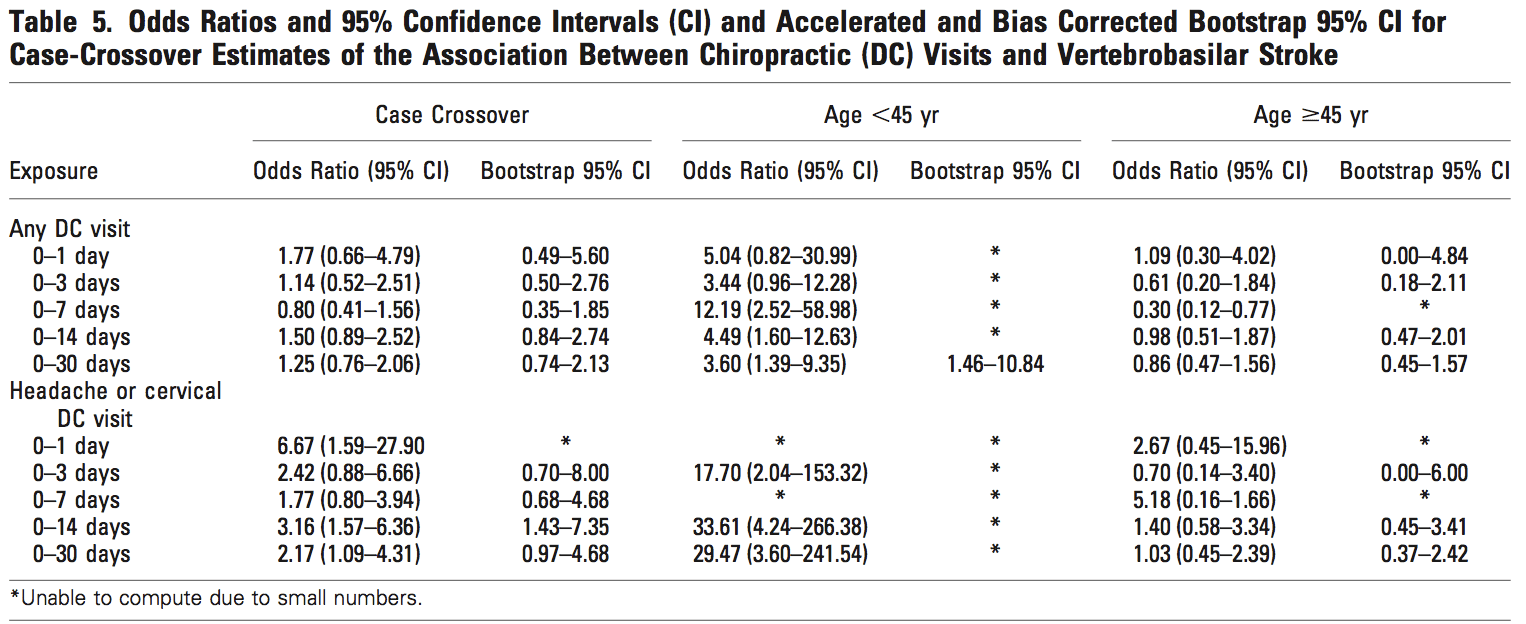
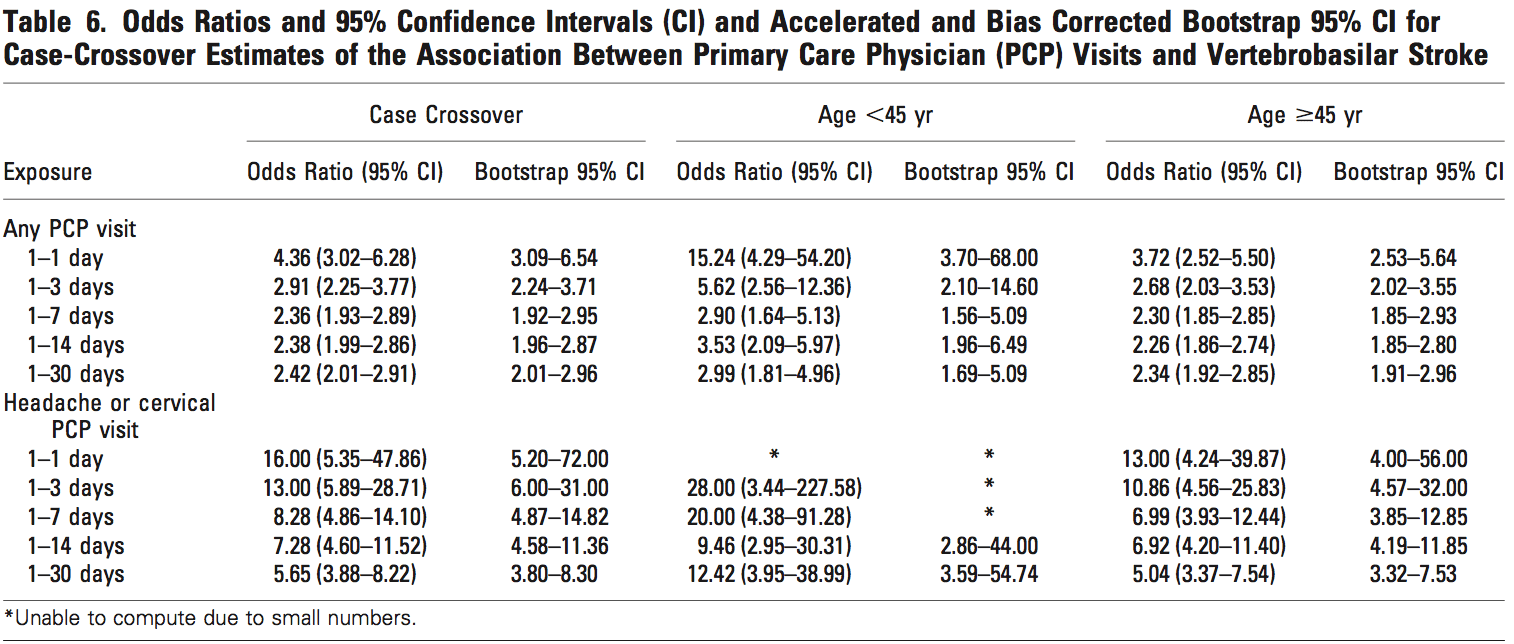

Similarly, we found that visiting a PCP in the month before the index date was associated with an increased risk of VBA stroke regardless of the hazard period, or the age of the subject. Each PCP visit in the month before the stroke was associated with an increased risk of VBA stroke both in those under 45 years of age (OR 1.34; 95% CI 0.94 �1.87 from the case crossover analysis) and 45 years and older (OR 1.52; 95% CI 1.36�1.67 from the case crossover analysis) (Table 7).
Our results were sensitive to chiropractic and PCP visits related to neck complaints and headaches, and we observed sharp increases in the associations when restricting the analyses to these visits (Tables 3�7). Overall,�these associations were more pronounced in the PCP analyses. However, the data are sparse, and we were unable to compute bootstrap confidence intervals in many cases.
Discussion
Our study advances knowledge about the association between chiropractic care and VBA stroke in two respects. First, our case control results agree with past case control studies that found an association between chiropractic care and vertebral artery dissection and VBA stroke.24,25 Second, our case crossover results confirm these findings using a stronger research design with better control of confounding variables. The case-crossover design controls for time independent confounding factors, both known and unknown, which could affect the risk of VBA stroke. This is important since smoking, obesity, undiagnosed hypertension, some connective tis- sue disorders and other important risk factors for dissection and VBA stroke are unlikely to be recorded in ad- ministrative databases.
We also found strong associations between PCP visits and subsequent VBA stroke. A plausible explanation for this is that patients with head and neck pain due to vertebral artery dissection seek care for these symptoms, which precede more than 80% of VBA strokes.23 Since it�is unlikely that PCPs cause stroke while caring for these patients, we can assume that the observed association between recent PCP care and VBA stroke represents the background risk associated with patients seeking care for dissection-related symptoms leading to VBA stroke. Be- cause the association between chiropractic visits and VBA stroke is not greater than the association between PCP visits and VBA stroke, there is no excess risk of VBA stroke from chiropractic care.
Our study has several strengths and limitations. The study base includes an entire population over a 9-year period representing 109,020,875 person-years of observation. Despite this, we found only 818 VBA strokes, which limited our ability to compute some estimates and bootstrap confidence intervals. In particular, our age stratified analyses are based on small numbers of ex- posed cases and controls (Table 2). Further stratification by diagnostic codes for headache and neck pain related visits imposed even greater difficulty with these estimates. However, there are few databases that can link�incident VBA strokes with chiropractic and PCP visits in a large enough population to undertake a study of such a rare event.
A major limitation of using health administrative data are misclassification bias, and the possibility of bias in assignment of VBA-related diagnoses, which has previously been raised in this context.24 Liu et al have shown that ICD-9 hospital discharge codes for stroke have a poor positive predictive value when compared to chart review.35 Furthermore, not all VBA strokes are secondary to vertebral artery dissection and administrative databases do not provide the clinical detail to determine the specific cause. To investigate this bias, we did a sensitivity analysis using different positive predictive values for stroke diagnosis (ranging from 0.2 to 0.8). Assuming non differential misclassification of chiropractic and PCP cases, our analysis showed attenuation of the estimates towards the null with lower positive predictive values, but the conclusions did not change (i.e., associations remained positive and significant�data not shown). The�reliability and validity of the codes to classify headache and cervical visits to chiropractors and PCPs is not known.
It is also possible that patients presenting to hospital with neurologic symptoms who have recently seen a chiropractor might be subjected to a more vigorous diagnostic workup focused on VBA stroke (i.e., differential misclassification).36 In this case, the predictive values of the stroke codes would be greater for cases that had seen a chiropractor and our results would underestimate the association between PCP care and VBA stroke.
A major strength of our study is that exposures were measured independently of case definition and handled identically across cases and controls. However, there was some overlap between chiropractic care and PCP care. In the month before their stroke, only 16 (2.0%) of our cases had seen only a chiropractor, while 20 (2.4%) had seen both a chiropractor and PCP, and 417 (51.0%) had�just seen only a PCP. We were not able to run a subgroup analysis on the small number of cases that just saw a chiropractor. However, subgroup analysis on the PCP cases (n 782) that did not visit a chiropractors during the 1 month before their stroke did not change the conclusions (data not shown).
Our results should be interpreted cautiously and placed into clinical perspective. We have not ruled out neck manipulation as a potential cause of some VBA strokes. On the other hand, it is unlikely to be a major cause of these rare events. Our results suggest that the association between chiropractic care and VBA stroke found in previous studies is likely explained by present- ing symptoms attributable to vertebral artery dissection. It might also be possible that chiropractic manipulation, or even simple range of motion examination by any practitioner, could result in a thromboembolic event in a patient with a pre-existing vertebral dissection. Unfortunately, there is no acceptable screening procedure to identify patients with neck pain at risk of VBA stroke.37 These events are so rare and difficult to diagnose that future studies would need to be multi-centered and have unbiased ascertainment of all potential exposures. Given our current state of knowledge, the decision of how to treat patients with neck pain and/or headache should be driven by effectiveness and patient preference.38
Conclusion
Our population-based case-control and case-crossover study shows an association between chiropractic visits and VBA strokes. However, we found a similar association between primary care physician visits and VBA stroke. This suggests that patients with undiagnosed vertebral artery dissection are seeking clinical care for head- ache and neck pain before having a VBA stroke.
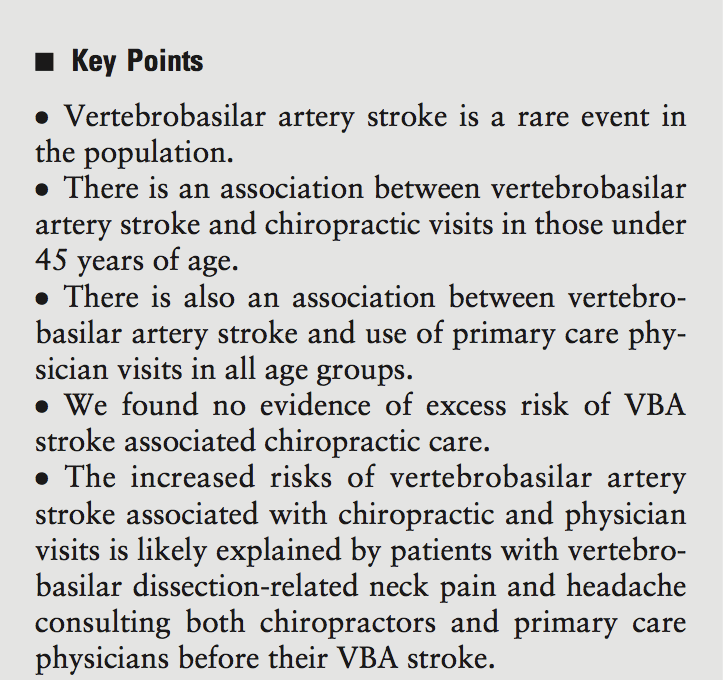
Acknowledgments
The authors acknowledge the members of the Decade of the Bone and Joint 2000 �2010 Task Force on Neck Pain and its Associate Disorders for advice about de- signing this study. In particular, they acknowledge the help of Drs. Hal Morgenstern, Eric Hurwitz, Scott Haldeman, Linda Carroll, Gabrielle van der Velde, Lena Holm, Paul Peloso, Margareta Nordin, Jaime Guzman, Eugene Carragee, Rachid Salmi, Alexander Grier, and Mr. Jon Schubert.
References
1. Borghouts JA, Koes BW, Vondeling H, et al. Cost-of-illness of neck pain in The Netherlands in 1996. Pain 1999;80:629�36.
2. Co�te� P, Cassidy JD, Carroll L. The Saskatchewan Health and Back PainSurvey. The prevalence of neck pain and related disability in Saskatchewan adults. Spine 1998;23:1689�98.
3. Co�te� P, Cassidy JD, Carroll L. The factors associated with neck pain and its related disability in the Saskatchewan population. Spine 2000;25:1109�17.
4. Co�te� P, Cassidy JD, Carroll L. Is a lifetime history of neck injury in a trafficcollision associated with prevalent neck pain, headache and depressive symptomatology? Accid Anal Prev 2000;32:151�9.
5. Co�te� P, Cassidy JD, Carroll LJ, et al. The annual incidence and course of neck pain in the general population: a population-based cohort study. Pain 2004; 112:267�73.
6. Co�te� P, Cassidy JD, Carroll L. The treatment of neck and low back pain: who seeks care? who goes where? Med Care 2001;39:956�67.
7. Hurwitz EL, Coulter ID, Adams AH, et al. Use of chiropractic services from 1985 through 1991 in the United States and Canada. Am J Public Health1998;88:771�6.
8. Hurwitz EL, Chiang LM. A comparative analysis of chiropractic and general practitioner patients in North America: findings from the jointCanada/United States Survey of Health, 2002�03. BMC Health Serv Res 2006;6:49.
9. Aker PD, Gross AR, Goldsmith CH, et al. Conservative management of mechanical neck pain: systematic overview and meta-analysis. BMJ 1996; 313:1291�6.
10. Gross AR, Kay T, Hondras M, et al. Manual therapy for mechanical neckdisorders: a systematic review. Man Ther 2002;7:131�49.
11. Hurwitz EL, Aker PD, Adams AH, et al. Manipulation and mobilization of the cervical spine. A systematic review of the literature. Spine 1996;21:1746�59.
12. McClune T, Burton AK, Waddell G. Whiplash associated disorders: a review of the literature to guide patient information and advice. Emerg Med J 2002;19:499�506.
13. Peeters GG, Verhagen AP, de Bie RA, et al. The efficacy of conservative treatment in patients with whiplash injury: a systematic review of clinical trials. Spine 2001;26:E64�E73.
14. Norris JW, Beletsky V, Nadareishvili ZG. Sudden neck movement and cervical artery dissection. The Canadian Stroke Consortium. CMAJ 2000;163:38�40.
15. Ernst E. Manipulation of the cervical spine: a systematic review of case reports of serious adverse events, 1995�2001. Med J Aust 2002;176:376�80.
16. Haldeman S, Kohlbeck FJ, McGregor M. Risk factors and precipitating neckmovements causing vertebrobasilar artery dissection after cervical trauma and spinal manipulation. Spine 1999;24:785�94.
17. Rubinstein SM, Peerdeman SM, van Tulder MW, et al. A systematic reviewof the risk factors for cervical artery dissection. Stroke 2005;36:1575�80.
18. Inamasu J, Guiot BH. Iatrogenic vertebral artery injury. Acta Neurol Scand 2005;112:349�57.
19. Schievink WI. Spontaneous dissection of the carotid and vertebral arteries. N Engl J Med 2001;344:898�906.
20. D�Anglejan-Chatillon J, Ribeiro V, Mas JL, et al. Migraine�a risk factor for dissection of cervical arteries. Headache 1989;29:560�1.
21. Pezzini A, Caso V, Zanferrari C, et al. Arterial hypertension as risk factor for spontaneous cervical artery dissection. A case-control study. J Neurol Neurosurg Psychiatry 2006;77:95�7.
22. Savitz SI, Caplan LR. Vertebrobasilar disease. N Engl J Med 2005;352: 2618�26.
23. Lee VH, Brown RD Jr, Mandrekar JN, et al. Incidence and outcome of cervical artery dissection: a population-based study. Neurology 2006;67: 1809�12.
24. Rothwell DM, Bondy SJ, Williams JI. Chiropractic manipulation and stroke: a population-based case-control study. Stroke 2001;32:1054�60.
25. Smith WS, Johnston SC, Skalabrin EJ, et al. Spinal manipulative therapy is an independent risk factor for vertebral artery dissection. Neurology 2003;60: 1424�8.
26. Arnold M, Bousser MG, Fahrni G, et al. Vertebral artery dissection: presenting findings and predictors of outcome. Stroke 2006;37:2499�503.
27. Maclure M. The case-crossover design: a method for studying transient effects on the risk of acute events. Am J Epidemiol 1991;133:144�53.
28. Kelman CW, Kortt MA, Becker NG, et al. Deep vein thrombosis and air travel: record linkage study. BMJ 2003;327:1072.
29. Mittleman MA, Maclure M, Tofler GH, et al. Triggering of acute myocardial infarction by heavy physical exertion. Protection against triggering by regular exertion. Determinants of Myocardial Infarction Onset Study Investigators.
N Engl J Med 1993;329:1677�83.
30. Redelmeier DA, Tibshirani RJ. Association between cellular-telephone calls and motor vehicle collisions. N Engl J Med 1997;336:453�8.
31. Janes H, Sheppard L, Lumley T. Overlap bias in the case-crossover design, with application to air pollution exposures. Stat Med 2005;24:285�300.
32. Janes H, Sheppard L, Lumley T. Case-crossover analyses of air pollution exposure data: referent selection strategies and their implications for bias. Epidemiology 2005;16:717�26.
33. Efron B, Tibshirani RJ. An Introduction to the Bootstrap. New York: Chapmanand Hall/CRC, 1993.
34. STATA/SE [computer program]. College Station, Tex: Stata Corp, 2006.
35. Liu L, Reeder B, Shuaib A, et al. Validity of stroke diagnosis on hospital discharge records in Saskatchewan, Canada: implications for stroke surveillance. Cerebrovasc Dis 1999;9:224�30.
36. Boyle E, Co�te� P, Grier AR, et al. Examining vertebrobasilar artery stroke in two Canadian provinces. Spine, in press.
37. Co�te� P, Kreitz BG, Cassidy JD, et al. The validity of the extension-rotation test as a clinical screening procedure before neck manipulation: a secondary analysis. J Manip Physiol Therap 1996;159�64.
38. van der Velde G, Hogg-Johnson S, Bayoumi A, et al. Identifying the best treatment among common non-surgical neck pain treatments: a decision analysis. Spine 2008;33(Suppl):S184�S191.
Key words: vertebrobasilar stroke, case control stud- ies, case crossover studies, chiropractic, primary care, complications, neck pain. Spine 2008;33:S176�S183
From the *Centre of Research Expertise for Improved Disability Outcomes (CREIDO), University Health Network Rehabilitation Solutions, Toronto Western Hospital, and the Division of Heath Care and Outcomes Research, Toronto Western Research Institute, Toronto, ON, Canada; �Department of Public Health Sciences, Management and Evaluation, University of Toronto, Toronto, ON, Canada; �Department of Health Policy, Management and Evalua- tion, University of Toronto, Toronto, ON, Canada; �Institute for Work & Health, Toronto, ON, Canada; �University Health Net- work Stroke Program, Toronto Western Hospital, Toronto, ON, Canada; and Division of Neurology, Department of Medicine, Fac- ulty of Medicine, University of Toronto, Toronto, ON, Canada. Supported by Ontario Ministry of Health and Long-term Care. P.C. is supported by the Canadian Institute of Health Research through a New Investigator Award. S.H.-J. is supported by the Institute for Work & Health and the Workplace Safety and Insurance Board of Ontario. The opinions, results, and conclusions are those of the authors and no endorsement by the Ministry is intended or should be inferred.
The manuscript submitted does not contain information about medical device(s)/drug(s).
University Health Network Research Ethics Board Approval number 05-0533-AE.
Address correspondence and reprint requests to J. David Cassidy, DC, PhD, DrMedSc, Toronto Western Hospital, Fell 4-114, 399 Bathurst Street, Toronto, ON, Canada M5T 2S8; E-mail: dcassidy@uhnresearch.ca
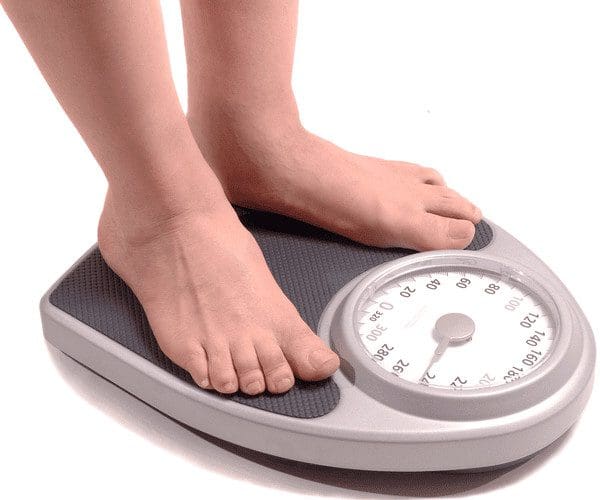
by Dr Alex Jimenez DC, APRN, FNP-BC, CFMP, IFMCP | Diets, Fitness
It’s no surprise — overweight children who don’t properly learn self-regulating habits likely become obese adults. What is surprising is that one of the most common ways to help — restricting children’s diets — actually compounds the problem.
That’s the thrust of a new study by University of Illinois researchers who point to a disturbing pattern: Parents shame by withholding food due to weight gain, then children cope with the negative emotions by overeating.
Further exasperating the trend, overweight children are often rewarded with food by parents, and as they grow older, the children reward themselves with food.
Researchers who studied the pattern added a genetic component as well to better understand obesity. They reported that a child’s genetics, relating to cognition and emotion, likely play a key role. They found that when biological conditions were just right, a nudge by the social aspect sets kids on a path to obesity.
Kelly Bost, co-author of the study (published in Pediatric Obesity), and professor of child development at the University of Illinois, said: “When parents offer food to children whenever they are upset, children may learn to cope with their negative emotions by overeating, and they start to develop this relationship with food early in life; eating — especially comfort food — brings a temporary soothing. People intuitively understand that.”
The findings support the team’s hypothesis that a correlation exists between all factors: parenting approaches, combined with a child’s genetic make-up and restrictive feeding, and the child’s weight and the child’s propensity to be obese.
Bost said that children can effectively learn control for themselves: “Some of the things parents do, they may not think are related to how children are developing their eating habits. The ways parents respond or get stressed when children get upset are related in an indirect way. The way we respond to that emotion can help children to develop skills for themselves, to self-regulate, so that everyday challenges don’t become overwhelming things that they have to manage with respect to food.”
Bost and her team used data from the “Strong Kids” program, outreach developed by The Oregon Resiliency Project, an organization that is based on “research, training, and outreach effort aimed at social and emotional learning, mental health promotion, and social-emotional assessment intervention” of children, according to the organization’s website.
The team examined information about parents’ feeding styles, and how they typically reacted to their children’s (ages 2.5 to 3 years) negative emotions. The researchers examined these factors in combination with genetic data.
For the genetic factor, they looked at the COMT gene, a gene known for regulating cognition and emotion. This gene is the gatekeeper for dopamine, which controls the brain’s reward and pleasure centers.
Bost and her team studied minute variances in the gene pool to determine which children might be more susceptible to negative emotions or stress. They based their genetic research on the breakdown of amino acids in proteins that could lead to personality differences. One of them is the change produced by genetics in the form of a single part of our DNA: the nucleotide polymorphisms (SNPs). There are many types of SNPs; some affect the composition of protein and, depending on the change, affect the amount of dopamine in the brain, as presented by Psychology Today. Dopamine controls the brain’s reward and pleasure centers.
One type of SNP can change an amino acid from valine (Val) to methionine (Met). While largely academic, these two types of proteins influence emotion. Bost explained it best in the study: “We all carry two copies of genetic information — one from Mom, and one from Dad. In a person with Val/Val, the COMT system works three to four times faster than those with other combinations do, and therefore accumulates less dopamine in the front of the brain. Children who have at least one copy of Val tend to be more resilient emotionally. Those who are Met carriers have the propensity to be more reactive to negative emotion or stress.”
This genetic component was combined with the researchers’ studies. “We know that how parents respond to their children’s negative emotions influences the development of children’s response patterns over time,” Bost said in the study. “There is a whole body of literature linking emotion dysregulation to emotional overeating, dysregulation of metabolism, and risk for obesity, even starting at early ages. We wanted to begin to integrate information from these various fields to get a more holistic view of gene-environment interactions at this critical time in life for developing self-regulation.”
They began their research with a group of 126 children who were studied for the social aspect. For the genetic component, saliva samples were taken. Parents filled out questionnaires, rating how they typically respond to their common situations, including emotional outbursts.
Bost and colleagues found that parents most likely to use restrictive feeding were those who reported more frequent use of unresponsive stress-regulating strategies with their children — punishing or dismissive —and had children who were higher weight status and tested positive for the Met amino acid. But the same was not necessarily true for children who were Val carriers.
Bost and her team determined that breaking the cycle did not begin with blaming parents but instead by encouraging them to develop positive reinforcement and other techniques that could help their kids respond better and also help develop positive eating habits that likely would carry into adulthood.
While there exist myriad programs that focus on providing good nutrition or how to plan less stressful mealtimes, Bost explains that parents should also learn emotion regulation strategies in response to children who display emotional breakdowns and are eating to soothe — especially if the parents are restricting foods.
She added, “Sometimes the way parents respond is based on their own stress, belief systems, or the way they were raised. Educating parents from a developmental perspective can help them to respond to their children’s emotions in ways that will help their children learn to self-regulate their emotions and their food intake . . . responsive parenting involves an understanding of what stress-reducing approaches are most effective for a particular child.”

by Dr Alex Jimenez DC, APRN, FNP-BC, CFMP, IFMCP | Diets, Fitness
A new diet plan that dictates that you eat only one food for several weeks to lose weight fast is drawing warnings from many experts who say it is dangerous and only successful in the short term.
The Mono Diet (sometimes called the Banana Island or Monotrophic Diet) was popularized by a YouTube star nicknamed “Freelee the Banana Girl” (real name: Leanne Ratcliffe) who claimed it helped her lose weight, the New York Post reports.
Ratcliffe claimed to have lost 40 pounds eating close to 30 bananas a day.
A new version, the Sweet Potato Diet, promises the spud can help you lose 12 pounds in just two weeks. The hashtag #monomeal on Instagram, which highlights pictures of people’s meals containing a single food, has more than 38,000 posts, and the diet was one of the most searched in 2016, according to Google.
Frances Largeman-Roth, a registered dietitian and author of “Eating in Color,” tells the Post you can lose weight by eating only one food, but it’s likely to result from eating less.
“Yes, this diet can produce weight loss,” she says “But, the weight loss is a result of caloric restriction — not because any particular food is magically producing weight loss. It’s an incredibly restrictive and unbalanced diet and I do not recommend that anyone follow it.”
Experts warn such diets can also cause symptoms like dizziness and lead to some serious health problems, including dangerous metabolic changes and muscle loss.

by Dr Alex Jimenez DC, APRN, FNP-BC, CFMP, IFMCP | Anti Aging
Here’s a scenario that’s probably easy for you to imagine: You’ve just endured a grueling flight to a far-off travel destination. After your arrival at the airport, you spot your luggage on the baggage carrousel. But as grab it, you feel that scary twinge in your back that feels like a pulled muscle or worse.
If this sounds like something you’ve experienced, you have plenty of company. Thousands of Americans suffer low back injuries when traveling each year. And, the truth is, the end of a long journey is the most dangerous moment for a traveler’s back, according to orthopedic specialists.
“When you rush to get your luggage and throw it on the cart to be the first to get customs and out, that’s when you can your hurt your back,” says Dr. Garth Russell, founding member of the Columbia Orthopedic Group in Missouri.
Travel can be a prescription for back pain and injury, experts agree. The long periods of forced immobility in airplanes, lifting the luggage packed with heavy documents or vacation gear, the fatigue, and the time pressure — not to mention the less-than-firm hotel beds — can add up to back spasms and sciatic nerve pain.
Since back pain is the most frequent cause of lost work days after the common cold, according to the American Academy of Orthopaedic Surgeons, it’s crucial take prudent precaution to protect your back when traveling.
“Summer vacation can spell disaster for your aching back if you don’t pay attention to how you move and how you prepare yourself for the journey,” says Dr. Richard Berger, a noted orthopedics surgeon and assistant professor of orthopedics at Rush University in Chicago. “People will be traveling in planes, trains and cars for hours and back pain can ruin even the best laid vacation plans.”
But Berger tells Newsmax Health a handful of back-saving tips can be the difference between a great vacation and a panful experience away from home. Here are his best suggestions:
Lift luggage in stages. “Move slowly and deliberately,” he says. “It’s the sudden jerking movements going full throttle that injure most patients.”
Never twist while lifting. This common error is the most frequent way people injure their back, says Berger, who explains that it takes much less force to cause injury when twisting than when lifting straight up and down.
Ask for help if you have back trouble. “Don’t hesitate to ask another passenger or flight attendant for help,” he says. “Explain your condition and most folks will be happy to assist.”
Ship bags instead. Mail your essentials to the designated destination and avoid luggage entirely. “With airline fees for checked luggage skyrocketing, this may also turn out to be an economical solution, too,” he says
Pack light. Moving a few light bags instead of one very heavy one, will likely avoid back injuries. “This is especially true if you are on an extended vacation with multiple stops so you have to transfer your bags in and out of your vehicles or into overhead bins and compartments,” he notes.
Plan for medication. If you are running low on your pain medication, get new prescriptions from your doctor and fill them so that you have enough. It may seem obvious but do not check medication with your luggage. “You may need them in flight or you may get delayed so that you may need more meds that you originally expected,” he says. Also: Bring backup over-the-counter medications such as Tylenol, Motrin or Aleve.
Ice, ice, baby. If you do suffer a back injury a pack of ice may be your first line of defense. Your flight attendant can fill a bag for you. Place it on your back for 20 minutes, then off for 20 minutes. Products like Icy Hot or Bengay Pain relief medicated patches may also provide relief.
Heat wraps work. There are disposable, portable hot packs that heat up after you open them and you can apply them as needed. Ask your pharmacist to suggest a few brands and check with your airline to make sure they allowed.
Muscle relaxants. These not only treat but may avoid back issues during a long flight. Ask your doctor if they are right for you.
Get the right seat. An aisle seat makes it easier to get in and out of your seat. Moreover, an aisle seat offers you the freedom to get up and move around more frequently.
Get up and move. This is crucial because sitting for an extend period of time stiffens the back muscles, putting stress on the spine and can cause pain. Get up to stretch often. Stretch the hamstrings muscles especially which will reduce stiffness and tension. If you are taking a road trip, stop for a stretch break every couple of hours.
Use a lumbar pillow. If you don’t own your own lumbar support, use a pillow, blanket or rolled up jacket to support the national curve of your back when traveling. Speaking of pillows, if you are staying in a hotel, your may sleep better if you bring your own pillow.

by Dr Alex Jimenez DC, APRN, FNP-BC, CFMP, IFMCP | Natural Health, Wellness
Whether your friend has hurt your feelings or you’re upset over a lovers tiff, swearing could help to ease your pain, according to new research published in the European Journal of Social Psychology.
Carried out by Dr Michael Philipp, a lecturer at Massey University’s School of Psychology, New Zealand, along with Laura Lombardo from the University of Queensland, Australia, the work looks at the effect of swearing on “short-term social distress,” which could be anything from an argument with your partner to being excluded from a social situation.
Although previous studies have looked at common methods for relieving both physical and social pain, fir example with paracetamol, none have so far looked at whether swearing aloud could also help relieve social distress in the same way that it has previously been shown to ease physical distress.
To test this idea, the study looked at Pain Overlap Theory, which suggests that physical and social/emotional pain share the same underlying processing system, and anything affecting physical pain will also have similar effects on social pain.
For the research 70 participants were split into two groups, and tested for feelings of social pain and sensitivity to physical pain.
During the study participants had to write either about an inclusive social situation, or a distressing one, to induce the corresponding emotions. They were then were randomly assigned to either swear aloud or say a non-swear word aloud.
The results showed that those participants who were socially distressed experienced less social pain and less sensitivity to physical pain than those who didn’t swear.
“Previous research suggests that social stressors, like rejection and ostracism, not only feel painful but also increase people’s sensitivity to physical pain,” explained Dr Phillip. He also added that swearing can help ease both social and physical pain by reducing its intensity, by distracting the person in pain.
However, Dr Phillip also pointed out that swearing may not have the same effect if used on an everyday basis or in a situation which is only mildly irritating or stressful, when the use of profanity may lose its impact.
He also added that swearing is not a quick answer for those experiencing serious emotional pain and stress such as grief or abuse, when clinical care may be needed.
Previous research on swearing has also found that cursing aloud can make you stronger. In a small-scale study published early last month, a team of researchers found that participants who completed a test of anaerobic power — a short, intense period on an exercise bike — and isometric handgrip test — produced more power and had a stronger grip if they swore while completing the exercises.

by Dr Alex Jimenez DC, APRN, FNP-BC, CFMP, IFMCP | Diets, Fitness
Bathing suit season is here, and for many of us that means no longer being able to hide those extra pounds beneath a chunky sweater. Fortunately, there are some small and easily implemented lifestyle adjustments that can quickly shrink your waistline.
Here are 10 ways to slim down for swimsuit season. The best part? None involve the gym.
Plan ahead: Making meals ahead of time can save you calories in the long run. Try cooking up large-batch dinners over the weekend and simply reheat throughout the week. Lisa Lillien, author of the “Hungry Girl” Website, featuring advice on guilt-free eating, suggests emphasizing lean proteins and veggies. Commit time on the weekend to meal prep and all you have to do is throw the ingredients in the pan during the week.
Drink more: Water, that is. Staying hydrated is important for your overall body function and can prevent you from feeling hungry. Sometimes the body confuses dehydration with the sensation of hunger. This problem comes with an easy solution — drink more water. Bring a travel water bottle with you when you’re on the go so you can remember to stay hydrated.
Limit or avoid alcohol: Cutting out alcohol is one of the quickest ways to lose weight. Alcohol triggers a process in the body similar to sugar. It can set off the same insulin resistance that can cause weight gain. For six days of the week, cut out alcohol.
Snack on healthy foods: Keep a variety of healthy snacks around to satisfy cravings. Protein bars and nuts are great snacks that will satisfy your hunger and prevent you from making poor food decisions at meal times. Fresh fruit and veggies are another great snack option.
Banish stress: Maintaining a healthy diet isn’t about never indulging. It’s about eating healthy foods the majority of the time and treating yourself on occasion. Don’t stress out if you veer off course. Instead, do what you can to get back on track. Stress can actually be a source of weight gain, so try to focus on the positive.
Careful with carbs: Processed white carbs are a no-no. They spike blood sugar levels and cause the pancreas to produce insulin, which causes the accumulation of fat. Instead, opt for refined carbs like brown rice and oats.
Start with soup: According to research from Penn State University, soup is a great diet food. The combination of liquids and solids helps make you feel full faster. Eat it before a meal and you may be able to decrease your overall calorie intake by up to 20 percent.
Consider your coffee: Black coffee isn’t a diet buster — it’s the milk and sugar that go in it. A latte from your favorite coffee shop can be a hidden source of fat and calories. Try swapping your usual espresso for a plain black or green tea.
Stop multitasking: A recent study in the American Journal of Clinical Nutrition found that multitasking while you eat will leave you feeling unsatisfied. Instead, slow down and enjoy your time savoring your meal without the distractions.
Spice it up: According to a recent study led by David Heber, a professor of medicine and director of the Center for Human Nutrition at the University of California-Los Angeles, capsaicin — the compound found in chili peppers — speeds metabolism and helps burn calories. Participants in the study were given a capsaicin supplement or a placebo for four weeks. The group who received capsaicin burned more fat for several hours after the meal for a total of 100 to 200 more calories a day. Spicy foods may also make you feel fuller more quickly than bland foods.










